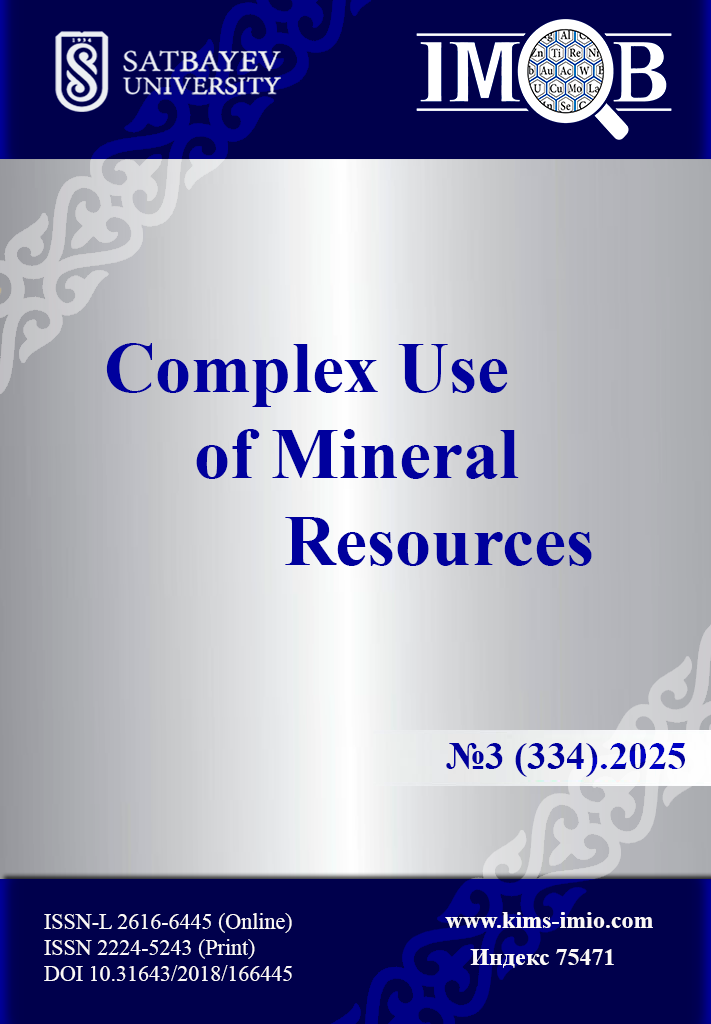Technology for extraction of Pb, Cu, Zn from a feed based on lead cake from leached dust generated by reduction-oxidation blowing of melt
DOI:
https://doi.org/10.31643/2025/6445.30Keywords:
lead cake, feed charge, intermediate products, reduction blowing, oxidation blowing, copper, lead, zinc, extraction.Abstract
The paper presents the theoretical basis and results of processing a mixture of complex types and compositions, based on lead cake, obtained after the preliminary removal of arsenic from dust and its subsequent leaching with sulfuric acid. The main goal of the technology is to involve the processing of substandard intermediate products of lead production together with lead cake and the selective extraction of non-ferrous metals into commercial products: copper into matte; lead - into rough lead: zinc - into slag. Choice of the composition of the feed charge was carried out taking into account the volumes obtained in production and is represented by the following structure, %: lead cake - 50; copper-lead matte – 40; quartz flux – 10. It has been established that the best results, ensuring high complex extraction of copper, lead, zinc and arsenic into the targeted smelting products, are achieved with a consumption of natural gas 1.4 times higher than its consumption from the stoichiometric required quantity (SRQ) for the reduction of lead compounds to metal lead. The optimal time for blowing the melt with natural gas is 15 minutes. The optimal oxygen consumption when blowing the intermediate matte obtained after the first stage was 1.1 times higher than its stoichiometric required amount (SRQ) for the oxidation of zinc and iron sulfide with their further transfer in the form of oxides to slag. The duration of matte blowing is 10 minutes. With the optimal established parameters, high technological indicators of the technology were achieved: extraction of lead into rough lead - 98.6%; copper in matte – 98.5%; zinc in slag – 94.1%.
Downloads
References
Kobayashi Y, Hirano S. Distribution and excretion of arsenic metabolites after oral administration of seafood-related organoarsenicals in rats. Metals. 2016; 6(10):231. https://doi.org/10.3390/met6100231
Feng S, Che J, Zhang W, Zuo Y, Wang C, Ma B, Chen Y. A sustainable approach for recovering copper and zinc from copper smelting flue dust: Paving the path for waste reduction. Separation and Purification Technology. 2024; 342:127037. https://doi.org/10.1016/j.seppur.2024.127037
Zhong DP, Li L, Tan C. Separation of arsenic from the antimony-bearing dust through selective oxidation using CuO. Metall. Mater. Trans. B. 2017; 48:1308-1314.
Yang WC, Tian SQ, Wu JX, Chai LY, Liao Q. Distribution and behavior of arsenic during the reducing-matting smelting process. JOM. 2017. https://doi.org/10.1007/s11837-017-2332-8
Vorotnikov AM, Lyzhin DN, Ipatova NS. Waste management system as an integral part of circular economy. Journal of economic research. 2018; 10:29-34.
Takezhanov ST, Erofeev IE. Concept Complex of technical and technological development of non-ferrous metallurgy in Kazakhstan. Almaty: Publishing house Kitap. 2001.
Orac D, Laubertova M, Piroskova J, Klein D, Bures R, Klimko J. Characterization of dusts from secondary copper production. J Min Metall Sect B – Metall. 2020; 56(2):221-228. https://doi.org/10.2298/JMMB190820011O
Jabłońska M, Rachwał MF, Wawer M, Kądziołka-Gaweł M, Teper E, Krzykawski T, Smolka-Danielowska D. Mineralogical and Chemical Specificity of Dusts Originating from Iron and Non-Ferrous Metallurgy in the Light of Their Magnetic Susceptibility. Minerals. 2021; 11(2):216. https://doi.org/10.3390/min11020216
Fry KL, Wheeler CA, Gillings MM, Flegal AR, Taylor MP. Anthropogenic contamination of residential environments from smelter As, Cu and Pb emissions: Implications for human health. Environmental Pollution. 2020; 262:114235. https://doi.org/10.1016/j.envpol.2020.114235
González A, Font O, Moreno N. Copper flash smelting flue dust as a source of germanium. Waste Biomass Valor. 2017; 8:2121-2129. https://doi.org/10.1007/s12649-016-9725-8
Chen J, Zhang W, Ma B, Che J, Xia L, Wen P, Wang Ch. Recovering metals from flue dust produced in secondary copper smelting through a novel process combining low temperature roasting, water leaching and mechanochemical reduction. Journal of Hazardous Materials. 2022; 430:128497. https://doi.org/10.1016/j.jhazmat.2022.128497
Adrados A, Merchán M, Obregón A, Artola A, Iparraguirre JA, GM, Cortázar Eguizabal D, Demey H. Development of a sustainable metallurgical process to valorize copper smelting wastes with olive stones-based biochar. Metals. 2022; 12(10):1756. https://doi.org/10.3390/met12101756
Li Q, Lai X, Liu Z, Chai F, Zhao F, Peng C, Liang Y. Thiourea-assisted selective removal of arsenic from copper smelting flue dusts in NaOH solution. Hydrometallurgy. 2024; 224:106246. https://doi.org/10.1016/j.hydromet.2023.106246
Che J, Zhang W, Deen KM, Wang C. Eco-friendly treatment of copper smelting flue dust for recovering multiple heavy metals with economic and environmental benefits. Journal of Hazardous Materials. 2024; 465:133039. https://doi.org/10.1016/j.jhazmat.2023.133039
Gao W, Xu B, Yang J, Yang Y, Li Q, Zhang B, Liu G, Ma Y, Jiang T. Comprehensive recovery of valuable metals from copper smelting open-circuit dust with a clean and economical hydrometallurgical process. Chemical Engineering Journal. 2021; 424:130411. https://doi.org/10.1016/j.cej.2021.130411
Baniasadi M, Vakilchap F, Bahaloo-Horeh N, Mousavi SM, Farnaud S. Advances in bioleaching as a sustainable method for metal recovery from e-waste: A review. Journal of Industrial and Engineering Chemistry. 2019; 76:75-90. https://doi.org/10.1016/j.jiec.2019.03.047
Gao W, Xu B, Yang J, Yang Y, Li Q, Zhang B, Liu G, Ma Y, Jiang T. Recovery of valuable metals from copper smelting open-circuit dust and its arsenic safe disposal. Resources, Conservation and Recycling. 2022; 179:106067. https://doi.org/10.1016/j.resconrec.2021.106067
Shi T, He J, Zhu R, Yang B, Xu B. Arsenic removal from arsenic-containing copper dust by vacuum carbothermal reduction–vulcanization roasting. Vacuum. 2021; 189:110213. https://doi.org/10.1016/j.vacuum.2021.110213
Chen Y, Zhu S, Taskinen P, Peng N, Peng B, Jokilaakso A, Liu H, Liang Y, Zhao Z, Wang Z. Treatment of high-arsenic copper smelting flue dust with high copper sulfate: Arsenic separation by low temperature roasting. Minerals Engineering. 2021; 164:106796. https://doi.org/10.1016/j.mineng.2021.106796
Liu X, Wu F, Qu G, Zhang T, He M. Recycling and reutilization of smelting dust as a secondary resource: A review. Journal of Environmental Management. 2023; 347:119228. https://doi.org/10.1016/j.jenvman.2023.119228
Downloads
Published
How to Cite
Issue
Section
License
Copyright (c) 2024 Dosmukhamedov, N., Zholdasbay, E., Argyn, A., Icheva, Y., & Klyshbekova, Z.

This work is licensed under a Creative Commons Attribution-NonCommercial-NoDerivatives 3.0 Unported License.


























